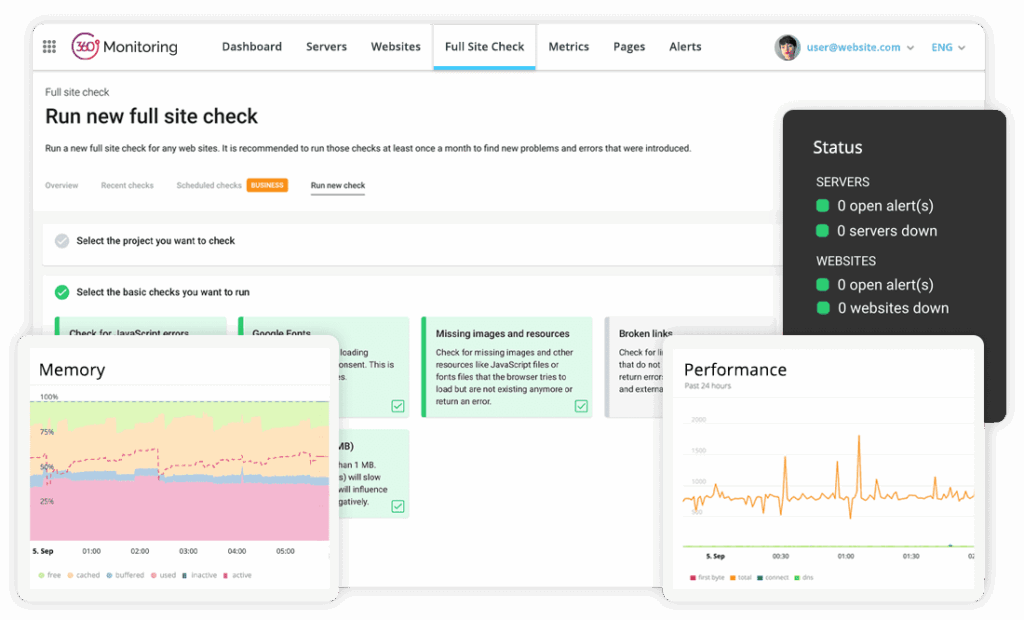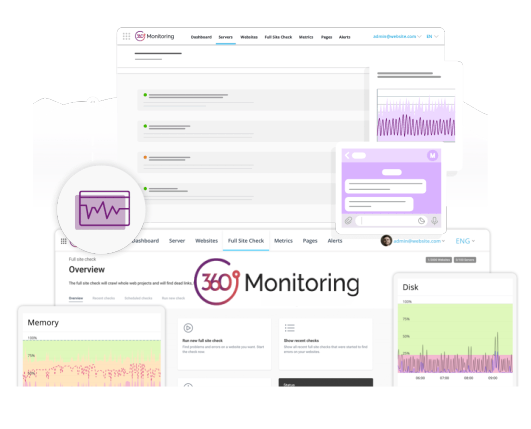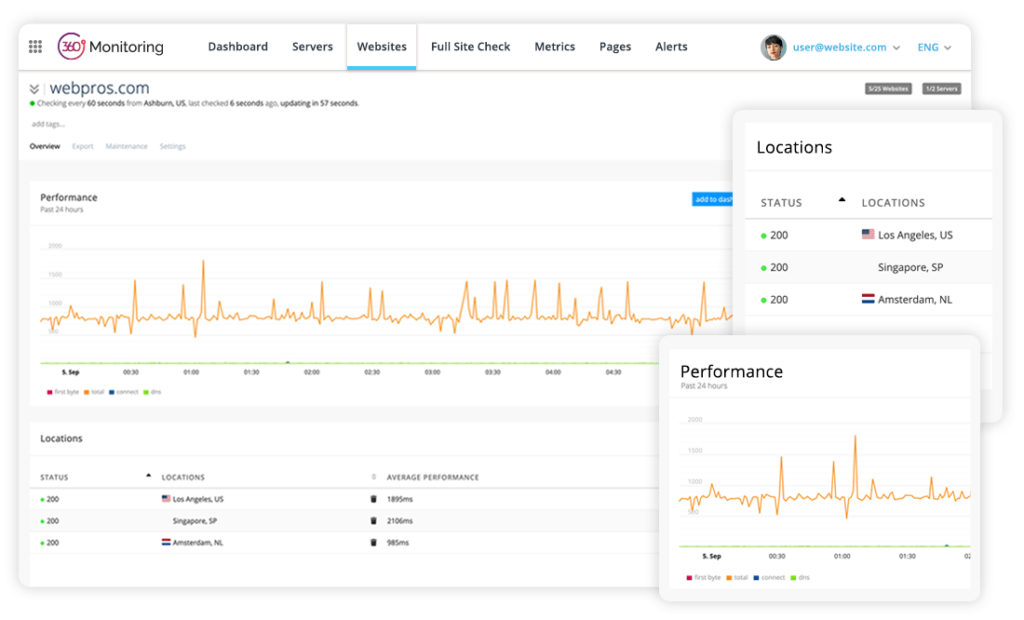360 Monitoring (Website & Server Monitoring)
Ensure your website and server operate at peak performance with 360 Monitoring, a comprehensive solution designed to meet your need for real-time insights, proactive issue detection, and uninterrupted uptime, safeguarding your business and enhancing user satisfaction. It integrates advanced website and server monitoring tools, empowering you to track performance, secure data, and optimize user experience without the need for technical complexity, all within a single, user-friendly dashboard.
What Is 360 Monitoring?
360 Monitoring is an all-in-one website and server monitoring platform that provides real-time insights into performance, availability, and security, enabling you to maintain optimal website and server health.
Built to support businesses of all sizes, it combines agent-based server monitoring with cloud-based website checks, offering metrics like CPU usage, response times, and uptime. For example, you can monitor a WordPress site’s load times and server resources simultaneously, identifying issues before they impact customers.
Related Service: AI Website Builder
Website Monitoring vs. Server Monitoring
Website monitoring in 360 Monitoring tests your site’s uptime, responsiveness, and functionality, while server monitoring tracks underlying server resources like CPU, memory, and disk usage. Website monitoring ensures your site is accessible and performs well for users globally, using cloud-based checks from multiple locations.
Server monitoring, facilitated by the Agent360 agent, provides detailed insights into server health, such as process performance and network traffic. For instance, website monitoring can alert you if a checkout page fails, while server monitoring identifies if high CPU usage is the cause, allowing targeted fixes.
Why You Need 360 Monitoring for Website and Server?
You need 360Monitoring to proactively detect and resolve issues, ensuring your website and server remain reliable, fast, and secure, minimizing downtime and protecting revenue. Tracking performance metrics, user behavior, and security threats helps you maintain a seamless online presence.
Features of 360 Monitoring
360 Monitoring offers a robust suite of features to monitor your website and server, including uptime checks, performance tracking, security scans, and user analytics, all integrated into a single platform. These tools empower you to optimize performance, protect data, and enhance user experience with actionable insights and real-time alerts.
Site Monitoring
360 site monitoring tracks uptime, response times, and functionality for protocols like HTTPS, TCP, and ICMP, ensuring your website remains accessible. You receive alerts for downtime or slow load times, enabling quick fixes to maintain user satisfaction.
Server Monitoring
Server monitoring in 360 provides detailed metrics on CPU, memory, disk usage, and network traffic via the Agent360 agent. You can identify resource bottlenecks, such as high memory usage, and optimize server performance proactively.
Security Monitoring
Security monitoring scans for malware, tracks suspicious logins, and monitors SSL certificate validity, protecting your site from threats. You stay ahead of vulnerabilities, ensuring customer data remains secure and compliant with standards like GDPR.
User Behavior and Analytics Monitoring
User behavior monitoring in 360 Monitoring analyzes metrics like bounce rates and click patterns, providing insights to improve engagement. You can optimize page layouts based on heatmaps, enhancing user experience and conversions.
Alerts & Notifications
This feature delivers instant alerts via email, SMS, Slack, or Telegram for issues like downtime or performance drops. You can respond immediately to prevent disruptions, with customizable alert settings to match your needs.
Integration with Hosting Panels
360 Monitoring integrates seamlessly with cPanel, Plesk, and WHMCS, offering centralized control within your hosting environment. You can manage monitoring directly from your hosting dashboard, simplifying workflows.
Technical Details and Advanced Features
360Monitoring provides a comprehensive set of advanced technical features, including detailed monitoring of web server processes, databases, mail servers, and specialized environments like PHP-FPM and Docker, delivering granular insights into your infrastructure’s performance.
These capabilities allow you to diagnose complex issues with precision, optimize resource usage, and maintain seamless operations across your entire stack, from web applications to backend systems, ensuring reliability for mission-critical platforms.
Related Service: Cheap Website Builder
Process Monitoring (NGINX, Apache, LiteSpeed)
Process monitoring meticulously tracks web server processes, such as NGINX, Apache, and LiteSpeed, analyzing metrics like CPU usage, memory consumption, and process counts to identify inefficiencies or bottlenecks. You can detect issues like a misconfigured NGINX process causing slow page loads or an Apache thread consuming excessive resources, enabling targeted optimizations.
If your WordPress site experiences delays due to high LiteSpeed process activity during a traffic surge, 360 Monitoring provides detailed reports on CPU and memory usage, allowing you to adjust configurations or scale resources to restore performance. This ensures your web server operates efficiently, supporting high-traffic scenarios without compromising user experience.
Database Monitoring (MySQL, MariaDB, MongoDB, Redis)
Database monitoring oversees critical databases like MySQL, MariaDB, MongoDB, and Redis, tracking query performance, connection times, and resource usage to ensure optimal operation in 360 Monitoring. You can identify slow queries, such as a poorly indexed MySQL query slowing product searches on an e-commerce site, or excessive Redis memory usage affecting caching performance.
Mail Server Monitoring (Exim, Postfix, IMAP, SMTP)
This technical feature in 360Monitoring ensures reliable email delivery by tracking performance metrics for Exim, Postfix, IMAP, and SMTP servers, including mail queue length, delivery times, and error rates.
You receive immediate alerts for issues like a backlog in the Exim mail queue or SMTP connection failures, preventing disruptions in customer communications, such as order confirmations or password reset emails. So it maintains seamless email operations, enhancing customer trust and engagement.
PHP-FPM, CloudLinux, and Docker Monitoring
360 Monitoring tracks PHP-FPM, CloudLinux, and Docker environments, monitoring resource allocation, process performance, and container health to ensure stability for web applications. You can optimize PHP-FPM processes to reduce latency in WordPress sites or isolate resource-heavy Docker containers running custom applications.
This ensures consistent performance for complex applications, preventing slowdowns or crashes during high-demand periods.
Queue, ElasticSearch, HaProxy, Asterisk Monitoring
360 Monitoring supports advanced monitoring for Queue systems, ElasticSearch, HaProxy, and Asterisk, providing insights into task queues, search performance, load balancing, and VoIP operations. You can track queue backlogs affecting task processing, optimize ElasticSearch for faster product searches, ensure HaProxy balances traffic efficiently, or monitor Asterisk for reliable call handling.
For example, if an e-commerce platform’s ElasticSearch instance slows during a sale, 360 Monitoring identifies high query latency, allowing you to optimize configurations or scale resources.
How 360 Monitoring Works
360 Monitoring operates through a sophisticated combination of agent-based server monitoring and cloud-based website checks, delivering real-time data, actionable insights, and proactive alerts to keep your infrastructure running smoothly.
By leveraging frequent scans, customizable monitoring intervals, and long-term data retention, it empowers you to prevent downtime, optimize performance, and maintain a seamless user experience across websites and servers.
Agent-Based Monitoring for Servers
Agent-based tools in 360 Monitoring use a lightweight, OS-agnostic tool installed on your server to collect detailed metrics on CPU, memory, disk usage, network traffic, and running processes. You gain deep visibility into server health, enabling you to identify issues like a memory leak in a Node.js application or excessive disk I/O from a misconfigured process.
The agent supports Windows and Linux, integrates with tools like cPanel and Plesk, and allows custom plugins for tailored monitoring, ensuring flexibility for your specific infrastructure.
Cloud-Based Monitoring for Websites
Cloud-based monitoring in 360 Monitoring tests website uptime, performance, and functionality from 26 global locations without requiring on-site software installation. You ensure your site is accessible worldwide by checking HTTPS responsiveness, DNS resolution times, and page load errors.
If a site’s checkout page fails in Europe due to a regional server issue, 360Monitoring alerts you with location-specific data, enabling you to reroute traffic or fix the issue. This approach provides consistent accessibility and performance for users across geographies, critical for global businesses.
Monitoring Intervals and Frequency
360 Monitoring offers flexible intervals, with scans as frequent as every 60 seconds, ensuring near real-time issue detection for both websites and servers. You can customize intervals to balance precision and resource usage, receiving timely alerts for critical events like server overloads or website downtime. So you stay informed without overwhelming your infrastructure.
Historical Reporting and Data Retention
Historical reporting in Spectrosoft 360 stores performance data for up to two years, with 30-day retention for recent scans, enabling you to analyze long-term trends and plan infrastructure upgrades. You can review metrics like recurring CPU spikes or disk usage patterns to anticipate resource needs. It provides you with actionable insights for proactive maintenance and capacity planning.
Full Site Check Process
The full site check process in 360 Monitoring scans entire websites, including private portals, e-commerce stores, and dynamic pages, for functionality, bugs, and errors like broken links or missing content. You receive comprehensive reports identifying issues, such as a slow-loading product page or an inaccessible login portal, enabling you to fix them before users are affected.
Tools and Resources for Monitoring
360 Monitoring provides a suite of tools, including the Agent360 agent, cPanel and Plesk integrations, and compatibility with third-party platforms like Slack and Telegram for alerts. You can enhance monitoring with tools like Pingdom for performance analytics or Host Tracker for additional uptime checks.
Custom plugins allow tailored monitoring, such as tracking a bespoke application’s metrics, ensuring flexibility for your infrastructure.
Advantages of Using 360 Monitoring
360 Monitoring maximizes uptime, enhances performance, and protects your business by delivering comprehensive insights, proactive alerts, and seamless integration with hosting panels, reducing operational risks and costs. Automating issue detection and providing actionable data saves time and resources, allowing you to focus on business growth while maintaining a reliable, high-performing online presence.
Maximize Uptime and Availability
360 Monitoring maximizes uptime by detecting downtime or accessibility issues instantly through frequent scans and global checks, ensuring your website remains available to users. You prevent revenue loss by resolving outages before they impact customers, such as fixing a downed checkout page during a flash sale.
Improve Website Speed and Performance
Website performance monitoring in the 360 program tracks critical metrics like Time to First Byte (TTFB), Largest Contentful Paint (LCP), and page load times, enabling you to optimize speed and reduce bounce rates.
You can identify and fix issues like slow DNS resolution or high TTFB, ensuring product pages load in under two seconds.
Protect Sensitive Data and Content
360 Monitoring protects sensitive data with robust security features, including malware scans, SSL/TLS certificate monitoring, and activity log tracking to detect suspicious logins or file changes. You maintain customer trust and compliance with standards like GDPR by preventing data breaches or unauthorized access.
Boost SEO Rankings
By ensuring consistent uptime, fast load times, and error-free pages, which are all critical for search engine algorithms like Google’s Core Web Vitals, 360 Monitoring boosts SEO rankings. You improve your site’s SERP position by resolving issues like slow DNS response times or broken links that could lower rankings.
Optimize User Experience and Engagement
360 Monitoring optimizes user experience by analyzing behavior metrics like bounce rates, click patterns, and heatmaps, providing data-driven insights to enhance engagement. You can redesign high-traffic pages based on user interactions, such as optimizing a product page’s call-to-action to reduce bounce rates.
Reduce Business Losses and Operational Downtime
Buying a 360 Monitoring plan reduces business losses by proactively addressing performance and security issues, minimizing downtime costs, and protecting revenue. You avoid lost sales from outages, such as a downed checkout page during a peak sales period, by receiving instant alerts and detailed diagnostics.
Why Choose Colonel for 360 Monitoring?
360 Monitoring leverages infrastructure, including Google Cloud’s Premium Tier Network and Agent360 technology. It ensures real-time insights, proactive issue detection, and seamless integration with cPanel and Plesk.
By choosing Colonel Server, you gain access to 360 Monitoring features, including website uptime monitoring, server performance monitoring, and security scans, ensuring your operations run smoothly while you focus on growing your business.







